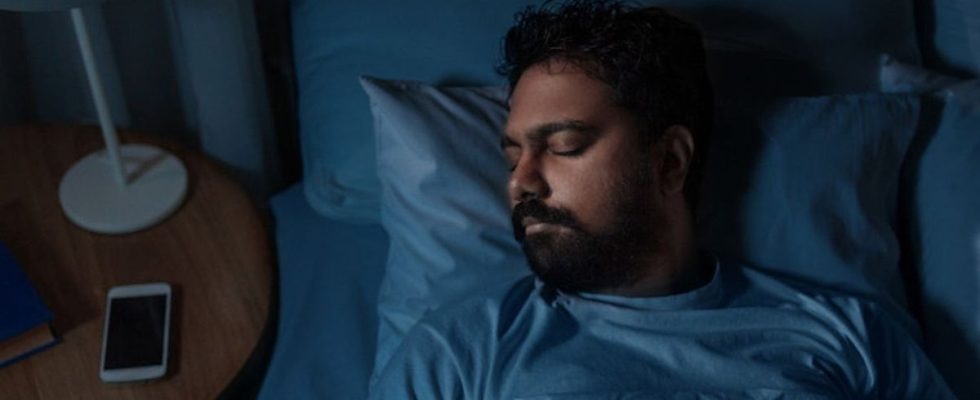Published on
Updated
Reading 4 min.
To fall asleep more quickly and avoid spending long minutes or even hours tossing and turning in bed, different methods and tips, more or less effective, are circulating, particularly on social networks. To mark International Sleep Day, Friday March 15, here are four techniques to try.
The 10-3-2-1-0 method
Popularized by fitness coach Craig Ballantyne, the 10-3-2-1-0 method consists of introducing a new routine into your daily life to enjoy a good night’s sleep, with each number corresponding to a very specific action. The 10th coincides with the elimination of caffeine ten hours before bedtime, the 3rd with the consumption of the last ‘big’ meal and/or glass of alcohol, and the 2nd with the necessary time between stopping work and falling asleep.
To complete it all, it is necessary to stop looking at screens for an hour before falling into the arms of Morpheus, and to never postpone waking up. When the latter rings, you have to get up and not try to grab a few extra minutes of sleep to face a new day. This technique, rather accessible, would not only allow you to sleep faster, but also to sleep better, according to the sports coach at least.
Brain tapping
This falling asleep technique involves tapping your face and body while repeating mantras to reduce stress and anxiety levels. Also called “Emotional Freedom Technique” (EFT), this tip is inspired by traditional Chinese medicine and kinesiology. To do brain tapping yourself before bed, you have to proceed from top to bottom. We start by tapping the first point located at the top of the head, then the one between the eyebrows. We then go down to the temples, under the eyes, the nose, the mouth and we finish with the collarbones, arms and chest. It is also possible to do tapping on the hair and wrists to maximize the relaxation effect on the body. We produce these movements while repeating motivating phrases like “I’m falling asleep” or “I’m relaxed.”
The method is approved by the scientific body. According to research dating from 2019 and published in the National Library of Medicine journal, it has been shown that EFT would help reduce anxiety levels. This process is also said to have other beneficial effects on the body and brain. Camille Junot, clinical psychologist for the Sleep and Vigilance Institute, explains to Madame Figaro : “Numerous scientific studies prove that gesture acts on the amygdala, the part of the brain that evaluates the events to which we are exposed to activate or not physiological stress mechanisms..” And added: “Gently tapping these points sends a reassuring signal, which prevents the appearance of stress symptoms and promotes sleep.“.
However, the results are random from one case to another. Camille Junot emphasizes that it is “It is important to identify the emotional cause of insomnia in order to remedy it.“If you have persistent insomnia problems, this method may not be suitable for you.
Sleep syncing
“Sleep syncing” (or sleep synchronization in French) allows you to regain control of your biological clock. Concretely, the concept consists of aligning your daily lifestyle with your circadian rhythm (or internal clock). This technique would promote more restful sleep and give you more energy every day.
Concretely, the ideal is “create a routine that signals the brain and body that it’s time to sleep and optimizes the internal circadian clock to function as it should“, explains Nilong Vyas, sleep coach to the magazine Women’s Health. If you feel, for example, that you become sleepy after 11 p.m., then this time could become the one at which you fall asleep every day. And if you wake up naturally around 9 a.m., that will be your wake-up time. You also need to ensure that you get enough sleep. It is estimated that the recommended amount of sleep for an adult is 7 to 9 hours. In order not to lose your bearings, it is recommended to keep a logbook in which you record your hourly routine.
If you can establish a bedtime and wakeup time that meets the recommended sleep duration, two weeks is enough to get your body used to your circadian rhythm. If the synchronization is well maintained, you will soon notice an improvement in your sleep as well as a boost in energy. You will wake up in better shape, saying goodbye to insomnia.
Consult a doctor online for your sleep problems
Moon Breathing
Moon breathing is a relaxation technique, often associated with yoga and meditation. Inspired by yoga, and popularized thanks to social networks, Tiktok in particular, it consists of regulating your breathing and your heart rate to help you fall asleep. This “moon breathing” is very simple to perform. Simply block your right nostril with a finger of your right hand and breathe deeply and lengthen the exhalation through your left nostril. Performed for five to ten minutes, comfortably seated, before going to bed, this technique allows you to relax and release emotions linked to stress, such as your worries of the day or the mountain of work that waits on your desk at work. the day after.
“We can practice lunar breathing at any time, day or night. Simply find a quiet corner, sit or lie down and inhale and exhale through each nostril for five times“, specifies Sita Sunar, yoga teacher in Amsterdam, Vogue India “Let yourself be guided by your natural breathing, free yourself from the hyperactivity of life and concentrate. This will help soothe your nerves, calm your mind and balance the body’s energies“.
